|
Early history
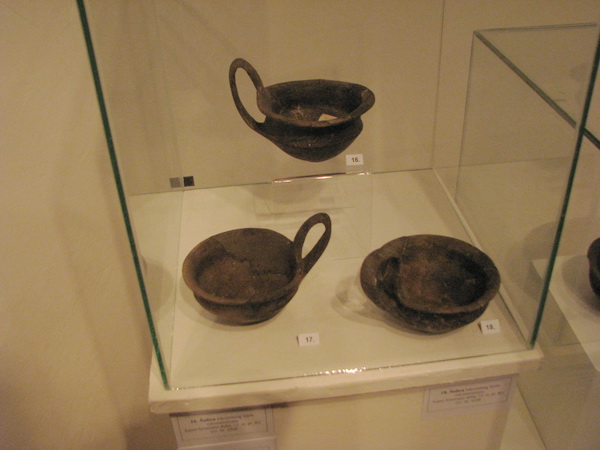 On
just a few square kilometers, visitors can experience the
spirit of history from the Copper Age, the Bronze Age, the
age of the Roman Empire, the turbulent Middle Ages, to the
Second World War. On
just a few square kilometers, visitors can experience the
spirit of history from the Copper Age, the Bronze Age, the
age of the Roman Empire, the turbulent Middle Ages, to the
Second World War.
On
the Kalnik area there are several archaeological sites from
the ancient history to the late Middle Ages. The oldest
archaeological site is located on the Stari grad Veliki
Kalnik complex, where the remains of Lasinja culture have
been found. That culture, which belongs to the Enolit period,
the Copper Age, 14th st. BC, densely inhabited the entire
Kalnik area. Among the important findings, it is worthy
to mention the archaeological site Igrišce, which belongs
to the Urnfield culture (the earlier Bronze Age). It was
found on Poucna staza (instructive trail).
Veliki Kalnik
 The
first written traces of Kalnik reach to the Middle Ages,
when the king Bela IV mentions it as a royal town, ''castrum
nostrum Kemluk'' because of its important role in the defense
from the Tatars. The
first written traces of Kalnik reach to the Middle Ages,
when the king Bela IV mentions it as a royal town, ''castrum
nostrum Kemluk'' because of its important role in the defense
from the Tatars.
The Middle Ages are a period of the biggest uprising of
Kalnik, which was the center of the county at the time.
As the old documents state, the name Veliki Kalnik at first
denoted the area of the Veliki Kalnik county, while the
medieval town (castrum, fortress) is mentioned under that
name in 1243 and 1264 as a royal property. Since the 14th
century, below the castrum, the medieval subordium named
Brezovica is being developed, from which the village Kalnik
has developed later on.
In the series of interesting facts from the rich history
of Veliki Kalnik, we can not fail to mention the legend
of the plum farmers of Kalnik, which tells us that the Tatars
tried to force the defenders of Kalnik to surrender by surrounding
and starving them, but the brave peasants secretly fed them
with plums and in that way made the conquerors give up further
conquest.
It is also interesting that, in the town dungeons, the Bulgarian
king Strahimir Aleksandrovic was being held hostage by King
Ludwig I from 1365 to 1369. Strahimir's numerous entourage
came with him to Kalnik. However, when king Strahimir was
returning to Vidin after the established peace and his release,
some of the Bulgarians didn't want to come with him because
they got married and made their homes below Kalnik hill.
In a charter from 1609, a judge from Brezovica Stjepan Bugarin
is mentioned. This last name remained in the area of Kalnik
and Kamešnica until today.
In the late 14th century, Hungaro-Croatian king Sigismund
(Žigmund) and his wife Barbara of Celje resided in Veliki
Kalnik. She was mean and known among the folk under the
name ''The Black Queen''.
The Turks never conquered Veliki Kalnik, although they invaded
it in the late 16th and 17th century, and in 1565, in the
nearby Obrež, they suffered one of their significant defeats.
Many later owners of Veliki Kalnik made alterations and
built annexes on the rocks, so that it has architectonic
elements in Romanesque, Gothic and Baroque style. In the
17th century, families Draškovic and Orehovecki owned the
fortress and the estate, later the families Ožegovic, Patacic
and, in the end, Ožegovic. After the end of the Turk danger
and the new security and economic organization in the 18th
century, the fortress Veliki Kalnik loses its function and
importance and the life moves to the village Kalnik and
further in the tame foothil region of Kalnik. Today's remains
date from numerous periods, and the high square tower is
the remains that especially stands out. It got its final
shape in the 16th century, with pillow-like corner stones,
beautifully hewn in the windows, and a spiral staircase
inside the fortress. In the eastern part of the old town,
foundations of a chapel are preserved. In the 17th century,
a Baroque court-yard has been added on. Today, a staircase
leads to the top of the fortress, and from the top of the
highest tower there is a beautiful view on the foothill
landscape. During good weather, the tops of Psunj, Papuk,
Zrinska gora and Petrova gora can be seen from the hill.
Church of St. Brcko
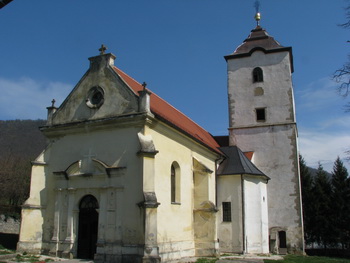 Church
of St. Brcko is mentioned as a parish church in 1501, but
the building itself is probably older, although there is
no written evidence. Church
of St. Brcko is mentioned as a parish church in 1501, but
the building itself is probably older, although there is
no written evidence.
Next to the church stands a monumental campanile tower,
which was a shelter from conquerors and robbers in the Middle
Ages. What makes it specific is a high entrance that could
be accessed only by ladders, and the narrow windows, so-called
arrow slits.
Valuable 14th century gothic frescoes from the earliest
phase of the construction have been preserved in the church.
The frescoes depict the death of the martyr St Peter of
Verona. They were a donation from King Ludwig I. This shows
the importance of the former free royal town Brezovice,
as well as the cultural church patrons, masters of the Great
Kalnik.
The church was reconstructed in 1518, when it got its late-gothic
structure, unchanged until today. In that phase of the reconstruction,
the entire sanctuary was painted with rustic wall paintings
(frescoes), which are probably the work of a local artist
from the early 16th century.
The frescoes from that period depict: Christ in glory, the
sun and the moon, symbols of the Evangelist Apostles and
angels on the ceiling; and on the walls, divided in three
zones: saints, apostles, the head of Christ, three-headed
Holy Trinity and two feudal donors (probably Tomo Bakac
Erdödy and the builder of the sanctuary Baltazar Alapic
or his son Ivan).
There used to be late-baroque furniture in the church, as
well as the 15th century gothic wooden carving ''The birth
of Christ'', which was brought to the parish church in Križevci,
where it has been until today.
With its architecture, Church of St. Brcko has an important
place in the Croatian sacral art, especially by revealing
the complex style changes of the late Middle Ages.
(Andela Horvat, Miljenka Fischer)
Chapel of St.Andrew
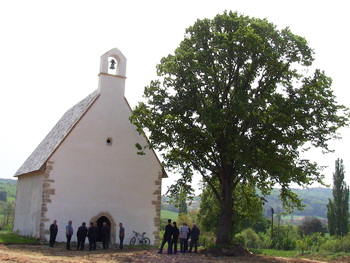 Chapel
of St. Andrew in Kamešnica is an example of a valuable gothic
chapel with baroque changes. The chapel is one of the rare
ones in the north-western Croatia which has preserved its
original gothic outside shape, while the gothic details
were devastated in the Baroque. Chapel
of St. Andrew in Kamešnica is an example of a valuable gothic
chapel with baroque changes. The chapel is one of the rare
ones in the north-western Croatia which has preserved its
original gothic outside shape, while the gothic details
were devastated in the Baroque.
The first written mention of the chapel dates from 1377,
when it was blessed by the Skradin's Archbishop Michael.
It's a one-nave building with a rectangular sanctuary.
The chapel entrance in the middle of the nave a spiked
stone portal, reminds of the gothic 15th century. There
is a rustic rosette on the main front, above which rises
a small rudimental campanile shaped as a distaff.
Traces of pointed gothic windows are also visible in the
chapel. These windows used to reach much lower to the ground,
but they were probably partially bricked up in the Baroque.
The chapel's roof was originally covered with wooden shingles,
which are assumed to be the only possible cover, considering
the steepness of the roof. The chapel got back its original
wooden shingles and distaff-shaped campanile in 2008.
In the documents from 1380, a manorial citadel on a location
near the chapel is mentioned, but today there are no significant
remains of it, except some scattered stone material around
the chapel.
Kalnik will give you a unique ambient
of rural landscape and its nature will enchant you with
its pureness and serenity.
GUIDED
TOURS AND ACTIVITIES
The Biblical Garden of Peace Tour
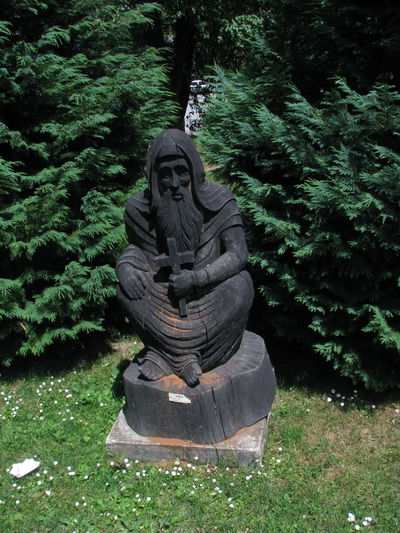 33
wooden sculptures depicting the events from the Old and
the New Testament located near the Elementary school in
Kalnik. 33
wooden sculptures depicting the events from the Old and
the New Testament located near the Elementary school in
Kalnik.
Duration of the
tour: approximately 30 min
The church of
St. Brcko Tour
Seeing the inside
of the church and the frescoes from 14th and 16th century,
a short presentation on the history of the church.
Duration of the tour: approximately 30 min
The Stari
Grad Veliki Kalnik fortress Tour
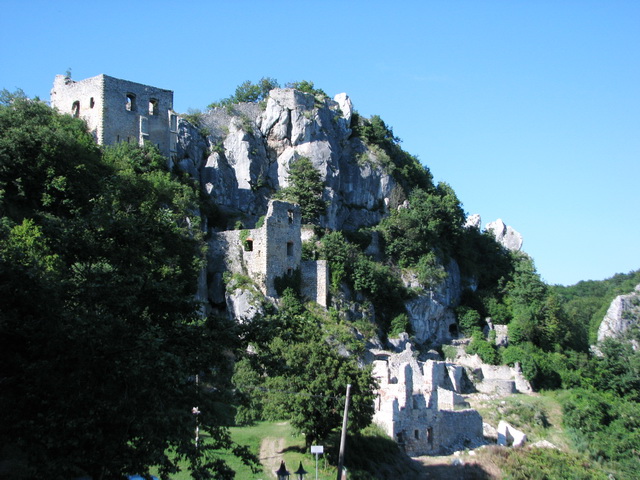 One of the most preserved fortresses in the Northwest Croatia
with a rich history. It is possible to climb on the top
of the fortress, from which spreads a beautiful view of
Prigorje, Podravina and Zagorje. A short presentation about
the history
One of the most preserved fortresses in the Northwest Croatia
with a rich history. It is possible to climb on the top
of the fortress, from which spreads a beautiful view of
Prigorje, Podravina and Zagorje. A short presentation about
the history
Duration of the
tour: approximately 1.5 hours
"Poučna staza" (the instructive path) tour
 Poučna
staza (the instructive path) is marked with descriptions
of plants, geological data about the Kalnik hill, historical
locations etc. The path has a round shape and shows the
most beautiful parts of Kalnik nature. On the path there
is an archaeological site from the Bronze Age and the remains
of the medieval church of St. Martin. Poučna
staza (the instructive path) is marked with descriptions
of plants, geological data about the Kalnik hill, historical
locations etc. The path has a round shape and shows the
most beautiful parts of Kalnik nature. On the path there
is an archaeological site from the Bronze Age and the remains
of the medieval church of St. Martin.
Duration of the
tour: approximately 2.5 hours
The ''7 teeth'' hiking trail
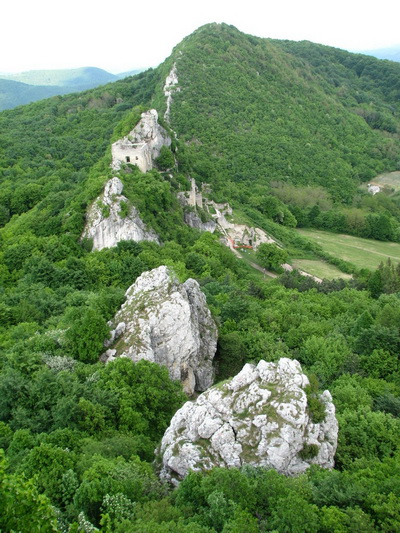 One
of the most beautiful hiking trails in Croatia, from which
beautiful sights in all four directions are given. The trail
leads to Vranilac, the highest peak of Kalnik. One
of the most beautiful hiking trails in Croatia, from which
beautiful sights in all four directions are given. The trail
leads to Vranilac, the highest peak of Kalnik.
Duration: approximately
2 hours
Paintball
It's possible to rent 6 sets of paintball equipment. The
locations for the play are very attractive because they
consist of natural rock barriers. Find out more details
about paintball on the link Paintball.
An expert guide takes you on a tour of all Kalnik sights
and presents interesting facts about the nature and history
of Kalnik.
The price of
the excursion:
- the expert
guide service costs 8 kuna per person
- lunch in the newly redecorated restaurant Planinarski
dom: 30 -60 kuna
For visiting
all the sights, no extra tickets are being sold.
Get more detailed information and reservations on the telephone
number 048/857-250
Mobile phone:
099/2138-501, fax: 048/270-760 or email: tz@kalnik.hr
contact person:
Kruno Durec
|